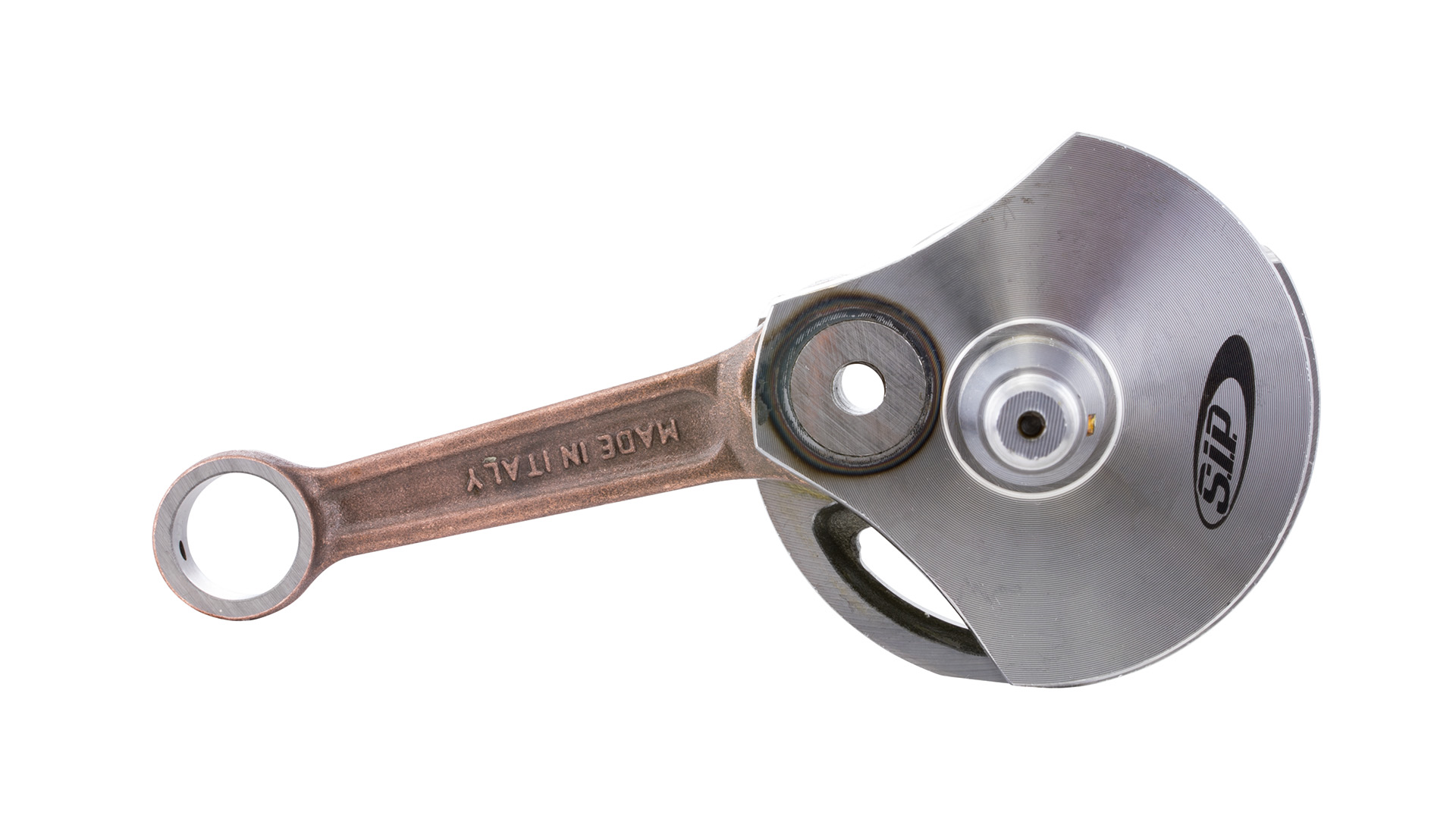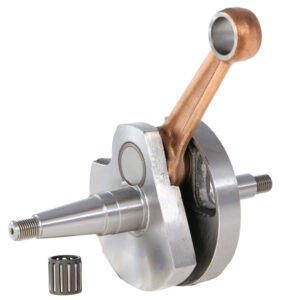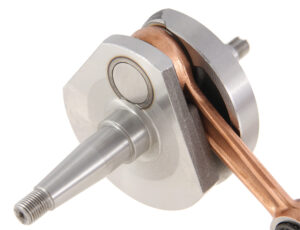A Vespa rolls. Everyone probably agrees on that. But when it comes to the question of what makes a Vespa roll, the answer is only clear at first glance. It would be obvious and basically correct to say that the tires are the decisive factor.
But the tires alone do not make it happen. In the background, the crankshaft ensures that the linear motion of the piston in the cylinder is transferred to a circular motion, which ultimately causes the tire to rotate. But in addition to this main task, the crankshaft has several other functions that play an important role in the drive system.
Four-link structure
The classic crankshaft basically consists of four parts. The crank webs, the crank pin, the connecting rod and a main bearing.
Each crankshaft has two crank webs, which are located opposite each other and are connected to the crank pin. The crank webs are usually made of particularly robust steel and have a special shape that enables the linear motion of the piston to be converted into a rotating motion.
The crankpin is the central part of the crankshaft to which the crank webs are attached. It is a robust component that must withstand high loads. This crankpin rotates in the main bearings, which are mounted in the housing and allow low-friction rotation of the crankshaft, ensuring that maximum power is transmitted directly.
The conrod, in turn, is connected to the piston and the crankshaft. It consists of a connecting rod and a connecting rod bearing. The connecting rod transmits the movement of the piston to the crankshaft and ensures smooth rotation.
Differentiation with regard to intended use
A distinction is made between standard crankshafts, racing crankshafts and special crankshafts.
The former are replicas of the originals, although in some cases improvements have been made, such as a gudgeon pin bearing for lower frictional torque instead of a bronze bushing or a polished forged connecting rod. The transition to racing shafts is sometimes fluid.
By racing crankshafts, we basically mean all crankshafts that deviate from the purely standard specifications. This means, above all, that they have a different crank web shape, allow more stroke, or have a longer or higher-quality connecting rod.
The assortment ranges from rotary vane shafts to diaphragm shafts, whereby a selection is often difficult even for ambitious hobby mechanics. For this reason, a brief distinction is now made between the two types.
Rotary vane shaft or diaphragm crankshaft?
The main difference between a rotary vane shaft and a diaphragm crankshaft lies in the way the fuel-air mixture enters the cylinder.
A rotary vane shaft is a crankshaft in which the intake port is controlled by a rotary vane. The rotary valve opens and closes the intake port as the crankshaft rotates. The mixture is drawn in by the vacuum in the crankcase and enters the cylinder through the intake port.
In contrast, a diaphragm crankshaft has a diaphragm plate between the crankcase and the intake port. The diaphragm plate has flaps or vanes that open and close to control the intake port. Negative pressure in the crankcase causes the diaphragm flaps to open and allow the mixture to flow into the cylinder. As soon as the vacuum decreases, the flaps close to prevent the mixture from flowing back.
The choice between a rotary vane shaft and a diaphragm crankshaft depends on a number of factors, most importantly the desired power delivery, torque curve and purpose of the engine. Rotary vane shafts are generally more robust and simpler in design, while diaphragm crankshafts allow better control of the mixture and offer a higher power range.
Now, which type you choose for your own Vespa should be well considered. First, you should familiarize yourself with your own model and then, ideally, seek advice from experts in order to select the right crankshaft for your own engine.
The experts from SIP Scootershop in Landsberg, who specialize in classic Vespa models, are a good source of help. They are available to provide competent support to ambitious Vespa riders either by telephone or directly at the flagship store. In the online store, there is also the entire range of original replacement shafts to high-end tuning shafts with helpful tips.
Engine development also positive for crankshafts
Basically, all historical models lend themselves to crankshaft replacement. Only the engines of the Vespa models from the early 50s were hardly used as a basis for tuning in the past. The technology of the wide-frame models is considered fragile and not able to take higher loads from more engine power.
But nevertheless, there are now also excellent crankshafts for largeframe models, which also cover sporty areas to be able to swim with the historic models relaxed in city traffic. The later developed Small- and Largeframe series enjoy nowadays clearly larger popularity with tuning measures, since here most diverse crankshafts for different needs can be installed. The simply constructed engines offer a wide variety of starting points for increasing performance. A significant and at the same time durable is the replacement of a suitable crankshaft.





